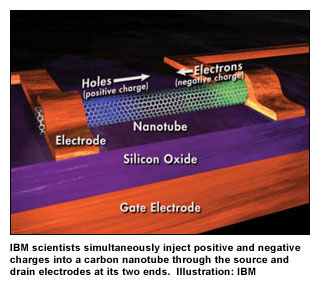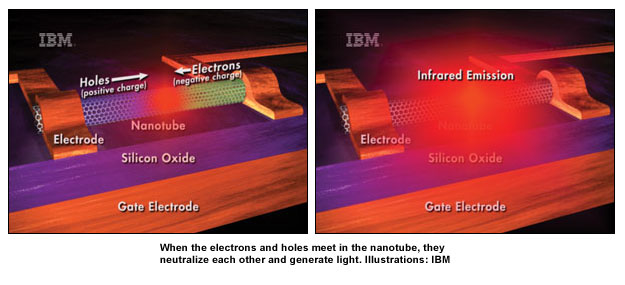YORKTOWN HEIGHTS, N.Y., May 9 -- The first electrically controlled, single-molecule light emitter has been created at IBM in what it calls a research breakthrough that demonstrates the rapidly improving understanding of molecular devices. It also suggests that the unique attributes of carbon nanotubes may be applicable to optoelectronics, the basis for the high-speed communications industry.

IBM scientists expect the achievement to spark additional research and interest in the use of carbon nanotubes in nanoscale electronic and photonic (light-based) devices. IBM's previous work on the electrical properties of carbon nanotubes has helped establish carbon nanotubes as a top candidate to replace silicon when current chip features can't be made any smaller. Carbon nanotubes are tube-shaped molecules that are 50,000 times thinner than an average human hair.
"By further understanding the electrical properties of carbon nanotubes through their light emission, IBM is accelerating the development path for their electronic applications, as well as possible optical applications," said Phaedon Avouris, manager of nanoscale science at IBM Research. "Nanotube light emitters have the potential to be built in arrays or integrated with carbon nanotube or silicon electronic components, opening new possibilities in electronics and optoelectronics."

IBM's research team detected light with a wavelength of 1.5 micrometers, which is particularly valuable because it is the wavelength widely used in optical communications. Nanotubes with different diameters could generate light with different wavelengths used in other applications.
IBM's light emitter is a single nanotube, 1.4 nanometers in diameter, configured into a three-terminal transistor. As in a conventional semiconductor transistor, applying a low voltage to the transistor's gate switches current passing between opposite ends of the nanotube (the device's source and drain).
Building on their previous research, IBM scientists engineered the device to be "ambipolar," so they could simultaneously inject negative charges (electrons) from a source electrode and positive charges (holes) from a drain electrode into a single carbon nanotube. When the electrons and holes meet in the nanotube, they neutralize each other and generate light.
Because it is a transistor, IBM's light emitter can be switched on and off depending on the voltage applied to the gate of the device. Electrical control of the light emission of individual nanotubes allows detailed investigations of the optical physics of these unique one-dimensional materials. IBM researchers compared the detail characteristics of the emitted light with theoretical predictions to prove that the light was created by the electron-hole recombination mechanism.
While optical emission from individual molecules has been measured before, that light emission was induced by laser irradiation of samples of molecules. In the case of carbon nanotubes, light emission from a collection of large numbers of nanotubes suspended in a liquid irradiated with a laser has been reported previously.
The report on this work, "Induced Optical Emission from a Carbon Nanotube FET," by J.A. Misewich, R. Martel, Ph. Avouris, J.C. Tsang, S. Heinze, and J. Tersoff of IBM's T.J. Watson Research Center in Yorktown Heights, N.Y., is published in the May 2 issue of Science.
For more information, visit: www.research.ibm.com